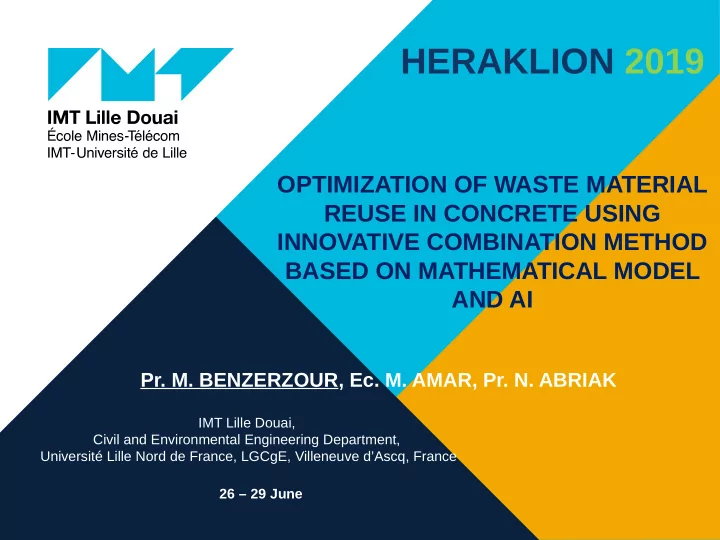

HERAKLION 2019 OPTIMIZATION OF WASTE MATERIAL REUSE IN CONCRETE USING INNOVATIVE COMBINATION METHOD BASED ON MATHEMATICAL MODEL AND AI Pr. M. BENZERZOUR, Ec. M. AMAR, Pr. N. ABRIAK IMT Lille Douai, Civil and Environmental Engineering Department, Université Lille Nord de France, LGCgE, Villeneuve d’Ascq, France 26 – 29 June
2 Context “WASTE” Cost Acceptability Life cycle Regulation / Policy Materials, structure Feasibility
3 Context Valorisation des SPI Complex Formulation Caractérisation Formulation decision Caractérisation Multi parameters Validatio Validatio n n Expérimentation Modélisation Expérimentation Modélisation Traitement Durability Environment Cost Traitement Durability Environment Cost Sediments Tires Fibres VP Slag Bauxaline Mâchefers Gravael
4 Context Dredged sediments + 500 million m 3 / year Sources of aggregates in Europe Immersion stocking stocking Immersion T emporary solution T oo important tonnage Environmental pollution Environmental pollution
5 Operational & IA approach : sediment reused Dragage /dredge déshydratation / drying ransport, cost, Stockage / storage, immersion CO2, … Caracterization Economic Traitement / Engineeri ng Ouvrage / Design T Environnemental Suivi / Monitoring Mathematical modeling IA Mathematical modeling IA
6 Operational & IA approach : sediment reused Mathematical operational approach Software : Input data Sediment Treatment Storage areas Materials center - Name - Name - Zone Name - T ype of sample - T ype (Inert, Not - Unit name - GPS coordinates - Characteristics dangerous, - T ransportation cost - T ype of treatment . Chemical (as, zn, ...) Dangerous) - Operating cost (or - For each type: . Mechanical (GTR) - GPS coordinates purchase) . Name of treatment - Centre of studies - Storage costs € / T - Characteristics . Cost € / T - dredging date - Notes . chemical . Impact on polluting - dredging location . mechanics element% - GPS coordinates - Notes - Address of the - T ransport costs T / center km - GPS coordinates - Operating costs - Notes - Notes
7 Operational approach : sediment reused Mathematical model : Objective function
8 Operational approach : sediment reused athematical model : Constraints ironmental constraints : Heavy metals ironmental constraints : Organic matter Mechanical constraints
10 Results Mathematical model : Validation 80 60 (PhD GPMD 2012) EXP 40 Experimental results : Optimal mixtures : SED 30%, SAND 70%, MODEL 20 Modelisation results : Optimal mixtures : SED 31,9%, SAND 68%, 0 SED SAND 80 60 (PhD LMCU 2013) EXP 40 Experimental results : Optimal mixtures : SED 40%, SAND 60%, MODEL 20 Modelisation results : Optimal mixtures : SED 41,4%, SAND 58,56%, 0 SED SAND 80 60 (PhD PRISMA 2015 ) PRISMA EXP 40 Experimental results : Optimal mixtures : SED 27%, SAND 73%, MODEL 20 Modelisation results : Optimal mixtures : SED 23,4%, DAND 76,3%, 0 SED SAND
IA approach : sediment reused Architecture Compressive strength Waste materials ❶ Building up a neural network ❷ Integrating 18 inputs, 2 hidden layers, 1 Output based on 1310 experimental data values. 3 /7/2019 11
IA approach : sediment reused Results • The fit is highly good for all data sets • R² values is 0.95 or above in each case. • There is Good correlation between predicted and actual values 3 /7/2019 12
Operational & IA approach : sediment reused Reusd possibility : Projects SETARMS, PRISMA, ECOSED, GPMD, SEDIMATERIAUX Dyke Road self-compacting concrete Aggregates Urban furniture Reservoir concrete pavement 13
FOUNDING MEMBERS OF THE CHAIR: CIRCULAR ECONOMY OF SEDIMENTS ECOSED DIGITAL 4.0 SIGNED ON JUNE 21, 2019 14 CONSEIL D'ÉCOLE - 28 MAI 2019
Recommend
More recommend